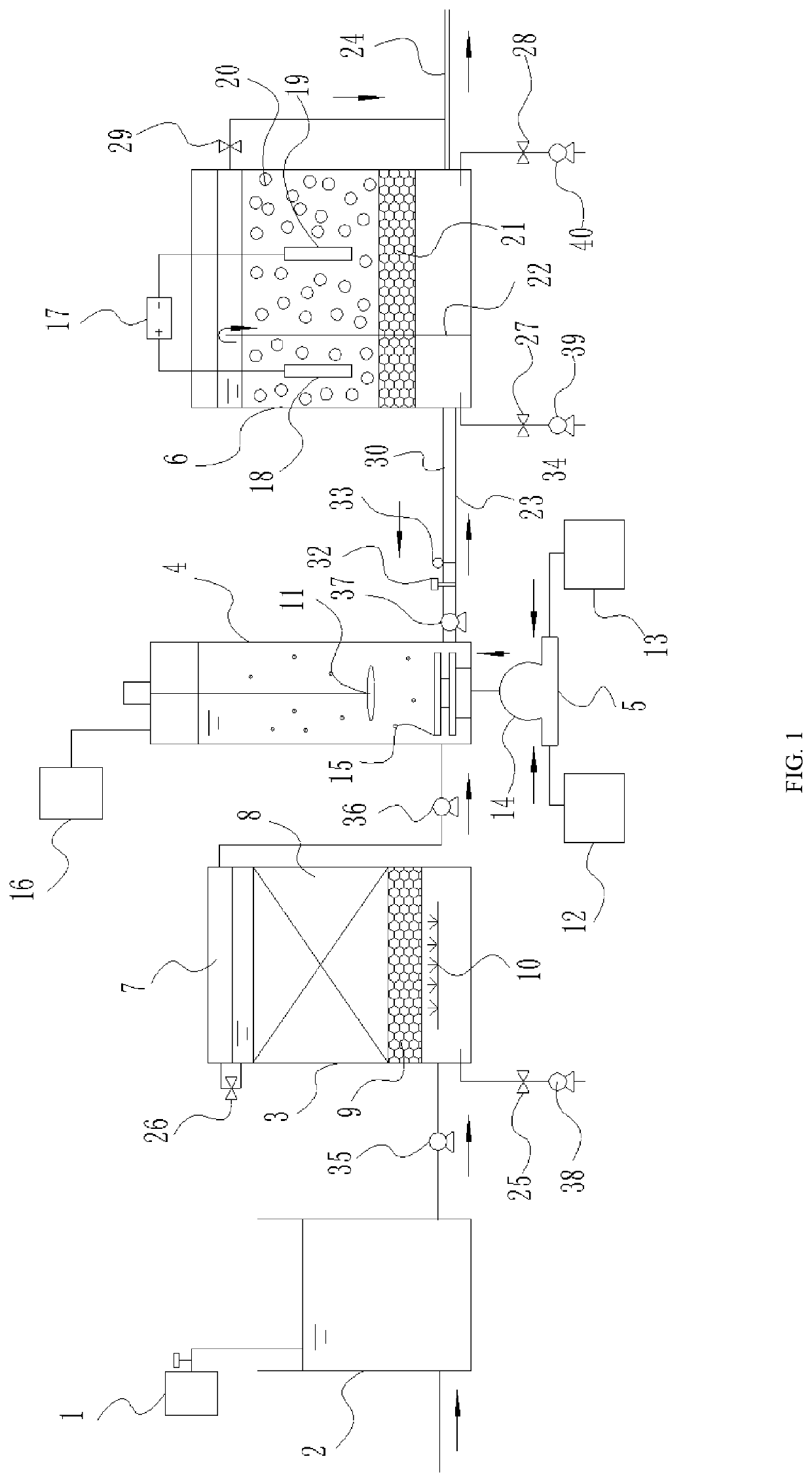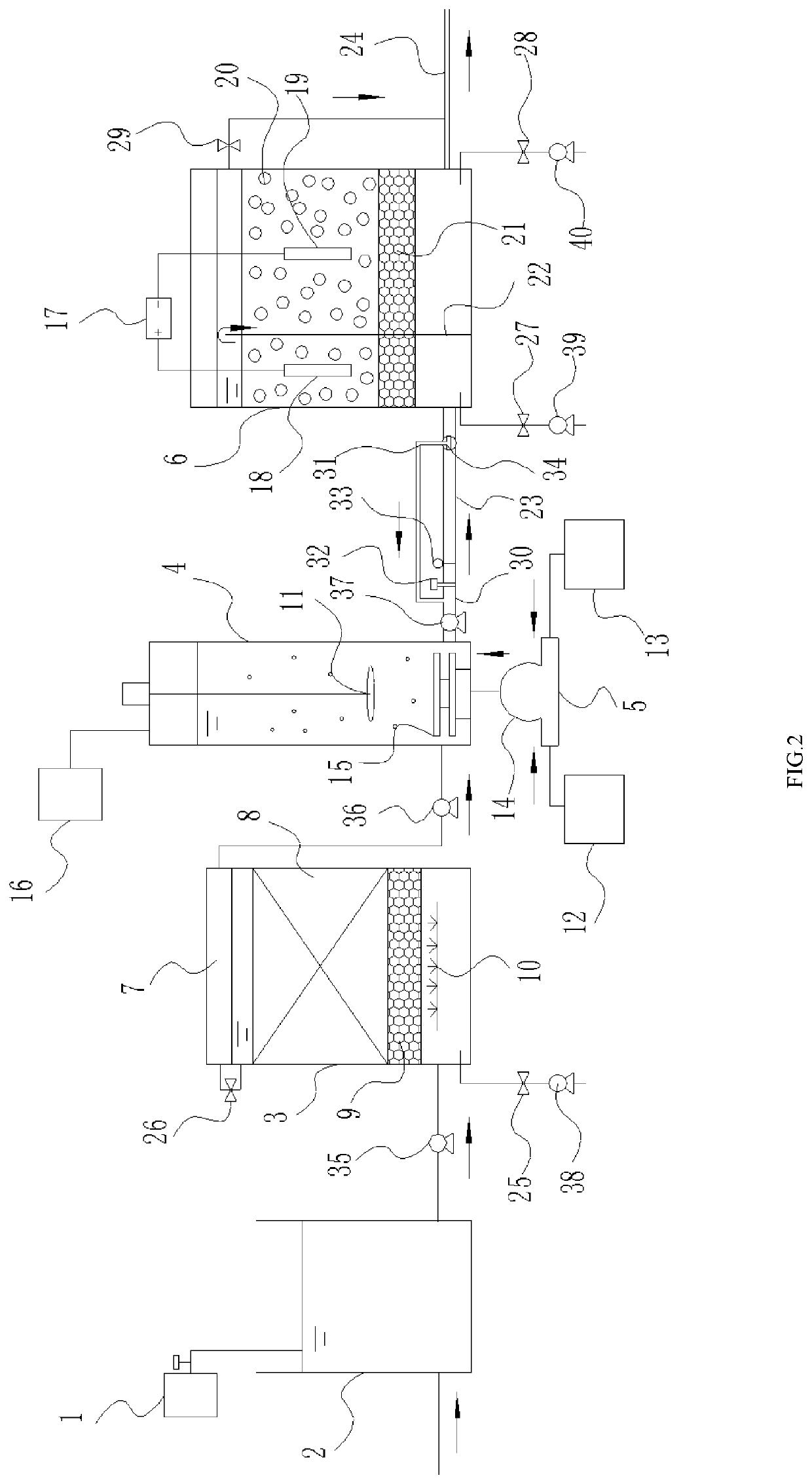Apparatus and operating method for deep denitrification and toxicity reduction of wastewater
a technology of denitrification and wastewater, applied in the direction of biological water/sewage treatment, multi-stage water/sewage treatment, sustainable biological treatment, etc., can solve the problems of reducing the amount of fish and shrimp, affecting and affecting the use of ozone, so as to increase the biodegradability of waste water and increase the utilization rate of ozon
- Summary
- Abstract
- Description
- Claims
- Application Information
AI Technical Summary
Benefits of technology
Problems solved by technology
Method used
Image
Examples
example 1
[0033]As shown in FIG. 1, an apparatus for deep denitrification and toxicity reduction of wastewater comprises: a regulating tank 2 connected to a wastewater source, which is introduced into the agent tank 1 in the regulating tank 2 through a dosing tube, and adjusts the pH of the wastewater to 7.0 using the agent inside the agent tank 1, and the wastewater is pumped into an aeration biofilter 3 through a first water pump 35, and a part of organic contaminants and ammonia nitrogen is removed by using aerobic microorganisms. The aeration biofilter 3 comprises: a lower aeration pipe 10 supplied by a gas supply device located outside the aeration biofilter 3, a first support layer 9 above the aeration pipe 10, which is a cobblestone layer with a gas-water ratio of 6, a first filler layer 8 above the first support layer 9, which is a ceramsite layer with a particle size of 5 mm and a porosity of more than 50%, and is used for providing an environment for the microorganisms to be attache...
example 2
[0047]Example 2 differs from Example 1 lies in:
[0048]As shown in FIG. 2, the ozone detection and flow control assembly 23 further comprises the electronic three-way valve 34 disposed on the main pipe 30 and close to the denitrification biofilter 6 to change the direction of the water flow, and the branch pipe 31 connected between the three-way electronic the valve 34 and the main pipe 30 upstream of the ozone detector 32 to circulate the unqualified effluent detected to the qualified level.
[0049]When the remaining ozone concentration exceeds 0.41 mg / L, the electronic three-way valve 34 turns to the circuit that connects the branch pipe 31 to the main pipe 30 and controls the time-controlled flow valve 33 to extend the residence time of the wastewater in the pipe until the remaining ozone concentration of the reflux in the wastewater is less than 0.41 mg / L and the wastewater is sent to the denitrification biofilter 6.
[0050]The main water quality indicators of the effluent were determ...
example 3
[0053]Example 3 differs from Example 2 in that:
[0054]In this Example 3, tetracycline-containing antibiotic wastewater was selected for deep denitrification and toxicity reduction treatment. The sampling amount was 100 L. Firstly, the main water quality indicators were determined by a water quality analyzer: COD=295-315 mg / L, TN=56-62 mg / L, NO3-N=19-22 mg / L.
[0055]The main water quality indicators of the effluent were determined and the results were: COD=17-25 mg / L, TN=2.3-4.5 mg / L, and NO3-N=0.8-1.5 mg / L. The removal efficiencies were: COD≥91.5%, TN≥92.0%, and NO3-N≥92.1%.
[0056]The results for biotoxicity assay showed that the inhibition rate of photobacterium decreases from 21%±3.5% to 7.5%±1.9%; when detection was made to tetracycline in the wastewater, -Ln(C / C0) finally reached 0.95.
PUM
| Property | Measurement | Unit |
|---|---|---|
| porosity | aaaaa | aaaaa |
| particle size | aaaaa | aaaaa |
| ozone concentration | aaaaa | aaaaa |
Abstract
Description
Claims
Application Information
 Login to View More
Login to View More - R&D
- Intellectual Property
- Life Sciences
- Materials
- Tech Scout
- Unparalleled Data Quality
- Higher Quality Content
- 60% Fewer Hallucinations
Browse by: Latest US Patents, China's latest patents, Technical Efficacy Thesaurus, Application Domain, Technology Topic, Popular Technical Reports.
© 2025 PatSnap. All rights reserved.Legal|Privacy policy|Modern Slavery Act Transparency Statement|Sitemap|About US| Contact US: help@patsnap.com


